Cite this document
(Sensory Evaluation Method Assignment Example | Topics and Well Written Essays - 1750 words, n.d.)
Sensory Evaluation Method Assignment Example | Topics and Well Written Essays - 1750 words. https://studentshare.org/business/1499361-sensory-evaluation
Sensory Evaluation Method Assignment Example | Topics and Well Written Essays - 1750 words. https://studentshare.org/business/1499361-sensory-evaluation
(Sensory Evaluation Method Assignment Example | Topics and Well Written Essays - 1750 Words)
Sensory Evaluation Method Assignment Example | Topics and Well Written Essays - 1750 Words. https://studentshare.org/business/1499361-sensory-evaluation.
Sensory Evaluation Method Assignment Example | Topics and Well Written Essays - 1750 Words. https://studentshare.org/business/1499361-sensory-evaluation.
“Sensory Evaluation Method Assignment Example | Topics and Well Written Essays - 1750 Words”. https://studentshare.org/business/1499361-sensory-evaluation.


